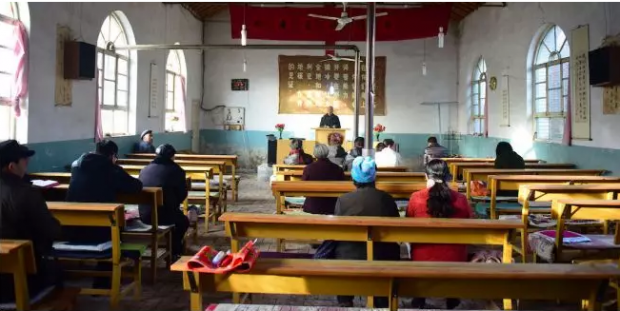The rural and urban churches encountered two different situations in the midst of the COVID-19 pandemic. Compared to the anxiety crisis in the urban church, the rural church has demonstrated its unique resilience.
Xiao Chen is a rural preacher and preaches in his own village. This church, according to him, has been around for years. He can't remember when the church started meeting, but believers in their 60s in the village said they started meeting soon after the opening up of the country.
After graduating from junior high school and working at home as a farmer for a few years, Chen joined the church thanks to the influence of his grandmother. Since he had higher educational qualifications, he was recommended by the church to study theology at an underground seminary for two years. After his graduation, he began to serve. He eventually became the main pastor of his church after the head pastor moved to the city to help his daughter with the children.
The congregation only had roughly 30 members, usually middle-aged and elderly women who were mostly at home looking after their grandchildren, tending to their fields, and feeding the livestock. The congregation was fairly stable and although the offerings were small, they were sufficient to cover the church’s daily expenses.
Chen's salary from the church was not fixed because his family also had fields. If there were many offerings during the Spring Festival, he would receive a little more, and if the offerings were small, he would get less. Sometimes, when the church was closed for a month during the busy farming season, there was no income whatever and he would receive no salary. But the salary amount did not affect him much.
With the start of the epidemic in 2020, social interaction restrictions in rural areas also begun to tighten. Gatherings in person were not allowed. On-line gatherings would have been impossible because most believers did not know how to use smartphones. They only used old button phones to receive calls from their children.
Due to the lockdown, everyone was confined to their homes and could only stay indoors. Besides telling everyone to stay home, read the Bible and pray, they sometimes could not hold any meetings for a month or two. When the storm passed and they were able to meet again, everyone returned. When the number of people who came was counted, they were virtually complete except for a grandchild too sick to attend.
The meetings took place at the home of a believer who happened to have a spare room. There was no rent to be paid, and tea was provided as well as an electric vehicle charging station. Brother Chen said that if the rent had to be paid, the church would have dispersed.
Three years into the pandemic, this was almost the norm. Sometimes they gathered, other times they did not. Of course, this also became the norm for their church, taking a holiday during the farming season for a month at a time and not meeting until the farming season was over. After each holiday, the numbers still did not decrease.
Chen's seminary classmate, however, was not so lucky. As soon as he graduated, he moved to a city to lead a campus fellowship. With the church supporting the rent and salary, things were going fine before the pandemic. The couple's church salary would cover the basic living expenses. But after the pandemic started, their meetings stopped completely. The closure of the school prevented the students from going out and the fellowship from holding meetings.
In the beginning, the fellowship's rent and salaries were paid on time, but later in 2021, it was delayed for a long time and during 2020 it became impossible to pay them properly. They had to close the fellowship and surrender their house, so they did not even have a place to live. Because of these difficulties, the lack of skills, or suitable jobs, the couple had to return to their hometown and wait for the situation to improve before returning to serve in the church.
The cost of running urban churches is relatively high, with high rents, salaries, and other running costs, and are therefore more sensitive to the economic climate. Therefore, the status of urban churches is bound to be affected by the economic environment. Rural churches, which are more mobile because of their low running costs, rent, and pastors’ salaries, are less affected by the economic climate. In addition, rural preachers rarely work full-time and are less dependent on the church, so pastoral work there tends to be more stable.
In terms of enthusiasm for the faith, gatherings were stopped during the lockdown period, but when the lockdown ended, believers in the rural areas would immediately return to church gatherings. The pandemic had little effect on them, rather the Christian faith provided them with a conviction to overcome the virus. Chen says that asking God to lead the way to an early eradication of the virus became a daily prayer.
As for cities, once the church stops meeting, the enthusiasm of believers may decline. Once meetings are suspended for a longer period, enthusiasm may disappear leading to a loss of believers. It is a tradition for rural churches to have a farming holiday during the farming season, so even though they stopped meeting during the pandemic, there was no loss of believers.
In between, of course, we should also see that the different circumstances in the city and the countryside create different expectations of how to approach the church. For middle-aged and elderly women who are busy farming and raising children, going to church meetings may be one of the few breaks they get after a busy week in the countryside. During the meetings, they are able to exchange family memories with friends, so they rely on these meetings.
For urban churches, it may be the other way around, as the cities are rich in entertainment and have many more churches. Compared to rural areas, work schedules are relatively stable and they have more leisure time than rural believers. All of this is disruptive to the enthusiasm of the believers to meet, so urban churches have a strong dependence on the believers and they themselves have to put in the necessary effort to retain other members.
As a result, we have seen that rural churches show more resilience and fortitude during the three-year period of the pandemic. Reducing church costs and the financial dependence of pastors on the church may therefore be key factors for increasing a church’s resilience.
- Translated by Nonye Nancy












